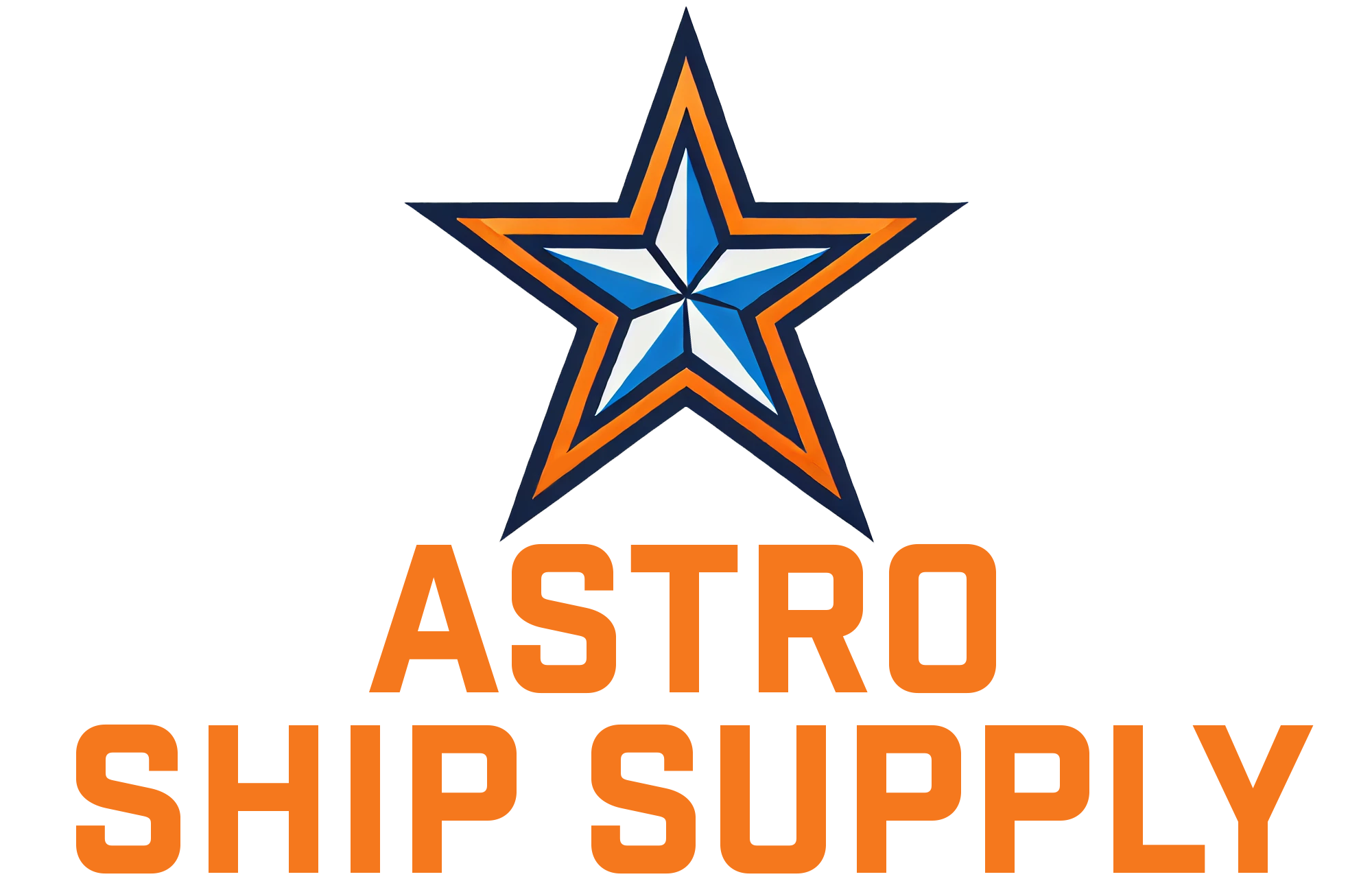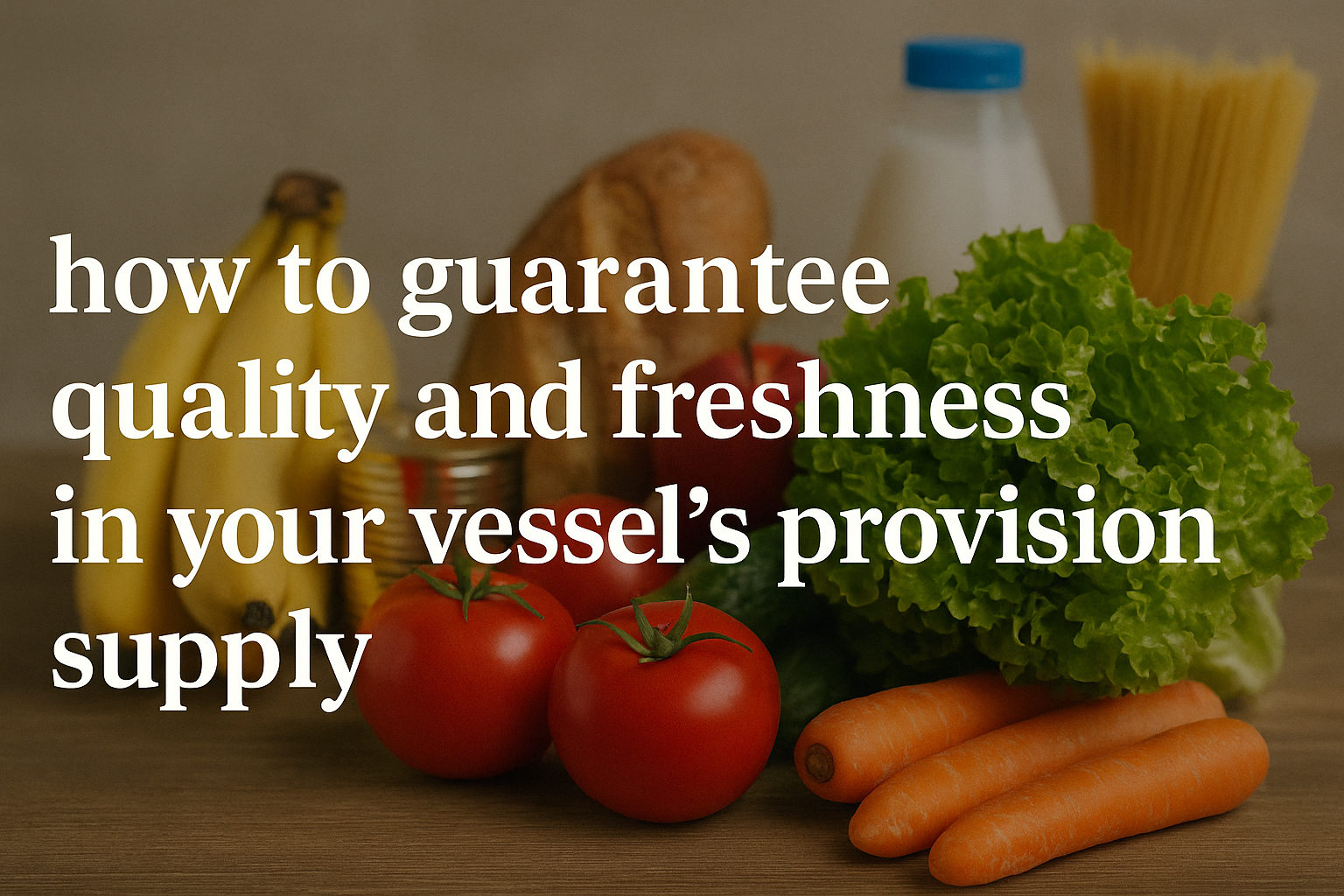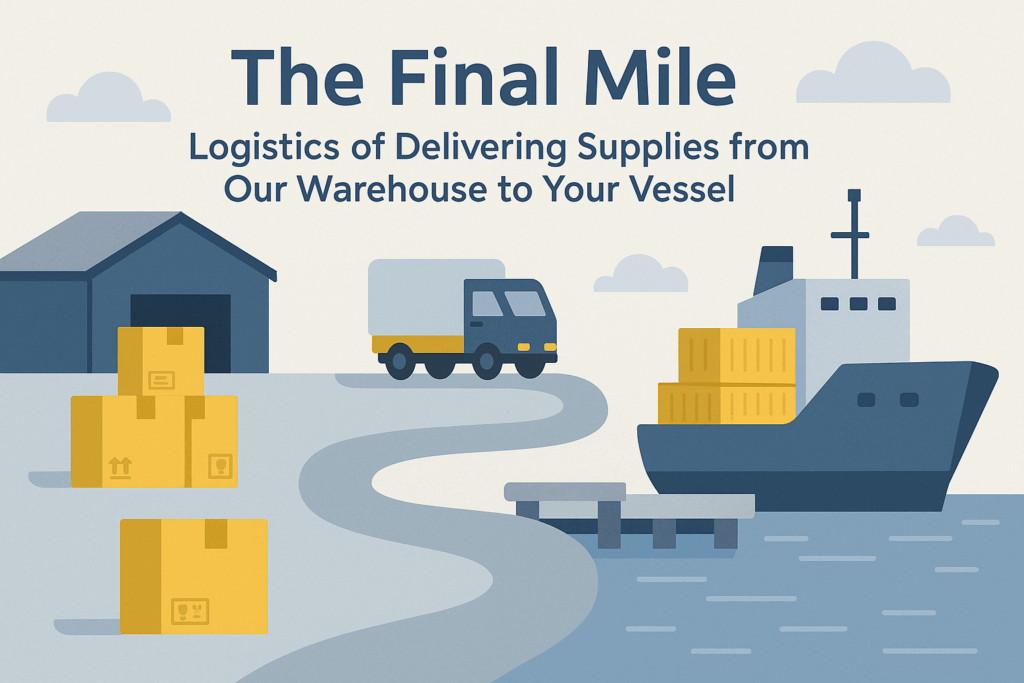The Far-Reaching Impact of Provision Quality on Maritime Operations
The quality of ship provisions sends ripples throughout the entire vessel operation, influencing far more than just mealtime satisfaction. Neglecting this crucial aspect can lead to a cascade of negative consequences, while prioritizing it yields significant operational and financial benefits.
Crew Health, Morale, and Performance
This is the most immediate and significant impact. Access to fresh, nutritious, and varied food is fundamental to:
- Physical Health: Preventing foodborne illnesses, nutritional deficiencies, and boosting immunity. A sick crew member can jeopardize safety and operational timelines.
- Mental Well-being & Morale: Good food is a powerful morale booster, especially during long and arduous voyages. It provides comfort and a sense of being cared for, combating stress and fatigue. Poor or repetitive meals can lead to dissatisfaction, demotivation, and even conflict.
- Cognitive Function & Alertness: Proper nutrition fuels the brain. For crew members responsible for navigation, engineering, and critical safety tasks, optimal cognitive function is non-negotiable.
High morale and good health directly translate into increased productivity, better teamwork, and a more positive onboard environment.
Operational Efficiency and Cost Implications
Provision quality, or the lack thereof, has tangible financial and operational repercussions:
- Reduced Medical Incidents: Preventing foodborne illnesses avoids costly medical evacuations, treatments, and potential P&I club claims.
- Minimizing Spoilage and Waste: High-quality, properly handled provisions have a longer shelf life, reducing waste. This is not only cost-effective but also environmentally responsible. Substandard supplies lead to higher spoilage rates, demanding premature replenishment and increasing overall costs.
- Avoiding Delays: Health outbreaks or severe dissatisfaction can lead to work stoppages or diversions to procure emergency supplies, causing expensive delays.
- Enhanced Crew Retention: Seafarers often cite food quality as a key factor in their decision to stay with or leave a company. High turnover rates incur significant recruitment and training costs.
Regulatory Compliance and Reputation
Adherence to food safety and quality standards is not just good practice; it’s often a regulatory requirement.
- Compliance with Maritime Labour Convention (MLC, 2006): The MLC stipulates requirements for food and catering, ensuring seafarers have access to good quality food and drinking water provided under regulated hygienic conditions. Non-compliance can lead to Port State Control detentions. For more on seafarer welfare, you can refer to resources from the International Labour Organization (ILO).
- Maintaining Company Reputation: A reputation for prioritizing crew welfare, including excellent provisions, can make a company an employer of choice and a trusted partner in the maritime industry. Conversely, incidents related to poor provisions can severely damage a company’s standing.
Navigating the Labyrinth: Key Challenges in Modern Ship Provisioning
Delivering consistent quality and freshness to vessels navigating global waters is a complex logistical feat, fraught with challenges that demand sophisticated solutions and experienced partners.
Global Sourcing Complexities & Varying Standards
Ships operate globally, requiring provisions from diverse ports. This introduces challenges such as:
- Inconsistent Local Standards: Food safety regulations, quality control, and handling practices can vary significantly from one port to another.
- Language and Cultural Barriers: Communicating specific requirements and understanding local product availability can be difficult.
- Traceability Issues: Ensuring the provenance and safety of products sourced from numerous international suppliers can be a significant hurdle.
The Tyranny of Distance and Time
The very nature of shipping means provisions must endure:
- Long Transit Times: Both from the original producer to the port supplier, and then from the supplier to the vessel, potentially during long voyages.
- Harsh Environmental Conditions: Temperature fluctuations, humidity, and motion at sea can accelerate spoilage if provisions are not adequately protected and stored.
Maintaining the Cold Chain Integrity
For perishable goods like fresh produce, dairy, and meats, an unbroken cold chain is non-negotiable.
- Multiple Transfer Points: Each handover (producer to distributor, distributor to chandler, chandler to vessel) is a potential point of failure for temperature control.
- Equipment Reliability: Dependence on refrigerated trucks, containers, and onboard storage facilities functioning perfectly.
- Monitoring and Verification: Ensuring consistent temperature throughout the chain requires robust monitoring, which isn’t always available or transparent.
Regulatory Patchwork and Documentation
Compliance involves navigating a complex web of:
- International Regulations: Such as MLC 2006, SOLAS, and MARPOL, which touch upon aspects of food safety and waste management.
- National and Local Port Health Regulations: Each port may have specific import requirements, inspection regimes, and health certifications.
- Customs and Biosecurity: Strict rules apply to the import of food items, particularly animal and plant products, to prevent the spread of diseases.
The Blueprint for Provision Excellence: A Step-by-Step Guide
Achieving consistent quality and freshness in your vessel’s provision supply requires a multi-faceted approach, focusing on meticulous planning, stringent processes, and reliable partnerships. Here’s how to build your blueprint for success:
Vetting Your Victualing Partner: Choosing a Supplier You Can Trust
Your ship chandler is the most critical link in your provision supply chain. Selecting the right one goes far beyond simply comparing price lists. Look for E-E-A-T signals (Experience, Expertise, Authoritativeness, Trustworthiness) in a potential supplier.
Key Hallmarks of a Top-Tier Provision Supplier:
- Verifiable Certifications: Accreditations like ISO 9001:2015 for quality management systems and HACCP (Hazard Analysis and Critical Control Points) for food safety are strong indicators of a supplier’s commitment to international standards. At Astro Ship Supply, we are proud to operate under these stringent certifications, ensuring every delivery meets rigorous benchmarks.
- Transparent Sourcing and Supply Chain: A reputable supplier should be able to provide information on where their products come from and how they manage their supply chain. For instance, our Texas-based supply chain prioritizes quality and traceability.
- Proven Track Record and Reputation: Look for testimonials, case studies, and industry references. How long have they been serving the maritime community? What do other vessel operators say about them?
- Robust Cold Chain Management: Inquire about their specific procedures for refrigerated and frozen goods, including temperature monitoring from warehouse to quayside.
- Comprehensive Product Range: Ability to supply a wide variety of international foods, catering to diverse crew nationalities and dietary needs. This includes fresh, frozen, dry goods, and often bonded stores.
- Excellent Communication and Support: A supplier should be responsive, proactive, and available for support – like our 24/7 availability via email, text, or phone.
Comparative Analysis: The “Transparent Trail” Supplier vs. “The Mystery Meat” Discounter
| Feature | “Transparent Trail” Supplier (e.g., Astro Ship Supply) | “The Mystery Meat” Discounter |
|---|---|---|
| Certifications (ISO, HACCP) | Publicly displayed, integral to operations. | Often absent or unverified. |
| Sourcing Transparency | Clear information on supply chain, local/regional focus where quality is assured. | Vague sourcing, often prioritizes lowest cost regardless of origin or handling. |
| Cold Chain Integrity | Documented procedures, temperature-controlled logistics, data loggers. | Minimal information, potential breaks in the cold chain to cut costs. |
| Quality Guarantees | Stands by product quality, clear process for addressing issues. | Limited recourse for substandard goods, “as-is” supply. |
| Long-Term Value | Focus on crew health, reduced waste, operational reliability leading to better overall ROI. | Apparent short-term savings often offset by spoilage, health issues, and crew dissatisfaction. |
Choosing a supplier like Astro Ship Supply, who embodies the “Transparent Trail” approach, means investing in reliability and peace of mind.
Precision in Procurement: The Art of Specifying Your Needs
Clear, detailed orders are fundamental to receiving the right provisions. Vague requests lead to misunderstandings and unsuitable supplies.
- Detailed Itemization: Specify exact quantities, preferred brands (if any), quality grades (e.g., Grade A produce), packaging sizes, and units of measure.
- Freshness Specifications: For perishables, indicate required shelf life or “packed on” dates where possible.
- Cultural and Dietary Accommodations: Clearly list requirements for different nationalities, religious diets (Halal, Kosher), and medical dietary needs (low sodium, gluten-free). Addressing “ordering specific dietary provisions for diverse crew” proactively prevents issues onboard.
- Seasonal Considerations: Be aware of seasonal availability for fresh produce to manage expectations and potentially opt for high-quality frozen alternatives when out of season.
The Unbroken Chain: Mastering Cold Chain Integrity
The cold chain is the lifeline for most fresh and frozen provisions. Any break can lead to rapid bacterial growth, spoilage, and food safety risks.
- Critical Control Points (CCPs): Understand these points from the supplier’s warehouse, during transit (refrigerated trucks/containers), at the quayside, during loading, and finally into the vessel’s stores. Each point needs to maintain the required temperature.
- Technology’s Role:
- Temperature Data Loggers: Small devices that travel with the shipment, recording temperature at set intervals. This provides an auditable record of temperature integrity.
- Real-time Monitoring Systems: Advanced systems in reefer containers and trucks can transmit temperature data continuously.
- Supplier Verification: Ask your supplier about their cold chain protocols. How do they ensure temperatures are maintained during loading and transport to the vessel? Do they provide temperature records?
Use Case: The Tale of Two Reefers
Imagine two reefer containers loaded with identical high-value frozen meat. Reefer A is equipped with a data logger and handled by a supplier with strict cold chain protocols. Reefer B is managed by a cost-cutting supplier with lax oversight. Upon arrival, the data logger from Reefer A confirms temperatures remained within the safe zone throughout transit. The meat is in perfect condition. Reefer B, however, experienced a temperature spike during a delay at the port, undetected by the supplier. The receiving crew, lacking data, might unknowingly accept partially thawed and refrozen meat, posing a serious health risk. This highlights the critical value of verifiable cold chain management.
Gateway Guardians: Rigorous Receiving and Inspection Protocols Onboard
Your crew are the final gatekeepers of quality. Empower them with the knowledge and tools to conduct thorough inspections upon delivery.
Onboard Provision Acceptance Checklist (Quotable List):
- ☑️ Verify Against Order: Check quantities, brands, and specifications match the purchase order.
- ☑️ Temperature Checks: Use a calibrated thermometer to check temperatures of chilled (0-5°C / 32-41°F) and frozen (-18°C / 0°F or below) items *before* accepting. Reject items outside safe temperature ranges.
- ☑️ Visual Inspection:
- Produce: Look for freshness, signs of bruising, mold, or wilting.
- Meats/Poultry/Fish: Check color, odor, and texture. Ensure packaging is intact and not leaking.
- Canned Goods: Inspect for dents (especially on seams), rust, or swelling.
- Dry Goods: Check for damaged packaging, signs of pests, or moisture.
- ☑️ Expiry Dates / Best Before Dates: Ensure adequate shelf life for the intended voyage duration. Prioritize items with shorter dates for earlier use (FIFO principle).
- ☑️ Packaging Integrity: Reject items with torn, damaged, or compromised packaging.
- ☑️ Documentation: Ensure all necessary delivery documents, including any temperature records or certifications, are provided by the supplier.
Refuse any items that do not meet these standards. It’s better to reject substandard provisions at the quay than to deal with the consequences at sea.
Smart Stowage: Preserving Quality Onboard
Once provisions are accepted, proper storage is crucial to maintain their quality and maximize shelf life.
- FIFO (First-In, First-Out): Always organize stores so that older stock is used before newer stock. Clearly label items with delivery dates.
- Proper Segregation:
- Store raw meats, poultry, and fish separately from ready-to-eat foods to prevent cross-contamination. Keep them on lower shelves in refrigerators to prevent drips onto other foods.
- Store fruits and vegetables appropriately; some require refrigeration, others do not. Ethylene-producing fruits (like apples, bananas) should be stored away from ethylene-sensitive produce (like lettuce, broccoli).
- Temperature Control: Regularly monitor and log temperatures in refrigerators, freezers, and dry storerooms. Ensure equipment is well-maintained.
- Cleanliness and Pest Control: Maintain scrupulous hygiene in all storage areas. Implement effective pest control measures.
- Ventilation and Humidity: Ensure dry stores are well-ventilated and protected from excessive humidity.
The Digital Advantage: Technology in Modern Provisioning
Technology plays an increasingly important role in streamlining ship provisioning and enhancing quality control.
- Inventory Management Systems: Software can help track stock levels, manage expiry dates, automate reordering, and reduce manual errors.
- Supplier Portals & E-procurement: Platforms that allow for easy ordering, tracking of deliveries, and communication with suppliers.
- Quality Feedback Systems: Digital tools for logging feedback on provision quality, enabling better tracking of supplier performance and continuous improvement.
While technology offers significant benefits, it’s a tool to support, not replace, rigorous processes and vigilant human oversight.
Astro Ship Supply: Your Partner in Provisioning Peace of Mind
At Astro Ship Supply, we understand that the provisions we deliver are vital to your vessel’s success and your crew’s well-being. Our commitment to excellence is woven into every aspect of our service, from meticulous sourcing through our trusted Texas-based supply chain to timely, reliable deliveries across the Port of Houston and the Gulf Coast region. We operate under stringent ISO 9001:2015 and HACCP guidelines, ensuring that the provisions you receive are not only fresh and of high quality but also handled with the utmost attention to food safety. Our team is dedicated to understanding your unique vessel specifications and crew requirements, offering customized solutions that you can depend on. We’re not just a supplier; we aim to be your trusted partner in maritime logistics. Learn more about our comprehensive approach on our About Us page or request a quote to experience the Astro difference.
Case Snippet: The “Sea Serpent” Success Story (A Hypothetical Scenario)
The M/V Sea Serpent, a bulk carrier on a demanding trans-Atlantic route, was consistently plagued by issues with its provision supply. The crew frequently complained about the poor quality of fresh produce, leading to rapid spoilage and limited meal variety. Morale was low, and the vessel experienced higher-than-average food waste. The vessel’s operator decided a change was crucial.
They transitioned to a new provision supplier who emphasized transparent sourcing, robust cold chain management (with verifiable data), and held HACCP certification. The supplier worked closely with the ship’s cook to understand specific dietary needs and preferences for the multinational crew. The new supplier implemented a system where temperature-sensitive goods were delivered with data loggers, and a clear protocol for receiving inspections was established with the crew.
The Results within three months:
- Significant Reduction in Spoilage: Food waste due to spoilage decreased by an estimated 40%.
- Improved Crew Morale: Feedback from the crew regarding food quality and variety became overwhelmingly positive. The ship’s cook reported fewer complaints and a more engaged dining experience.
- Enhanced Food Safety: With better quality ingredients and handling, the perceived risk of foodborne illness diminished.
- Cost Efficiency: While the per-unit cost of some items from the new supplier was marginally higher, the reduction in waste and the intangible benefits of higher morale translated to better overall value.
This scenario illustrates how a strategic shift towards a quality-focused provision partner, committed to best practices, can directly improve onboard conditions, crew satisfaction, and operational efficiency.
Final Thoughts: Charting a Course for Consistent Quality
Guaranteeing the quality and freshness of your vessel’s provisions is an ongoing commitment, not a one-time fix. It demands diligence, the right partners, and a culture of quality that extends from shoreside procurement to the galley onboard. By implementing the strategies outlined in this guide, ship operators and managers can significantly enhance crew welfare, optimize operational efficiency, and uphold the highest standards of maritime excellence. Your crew deserves the best, and ensuring they receive it is an investment that always pays dividends.
Frequently Asked Questions (FAQ)
What are the first signs of a failing cold chain for provisions?
Early warning signs include:
- Frozen items showing signs of thawing and refreezing (e.g., ice crystals inside packaging, misshapen products).
- Chilled items feeling warmer than they should be (above 5°C or 41°F).
- Excessive condensation on packaging within refrigerated units.
- Unusual odors from refrigerated or frozen goods upon opening.
- Premature spoilage of fresh produce shortly after delivery.
- Temperature loggers (if used) indicating out-of-range temperatures during transit.
Immediate inspection and temperature verification are crucial if any of these signs are observed.
How often should ship provision suppliers be audited?
While there’s no single mandated frequency, best practice suggests:
- Initial Audit: Before engaging a new primary supplier, a thorough audit of their facilities, processes, and certifications (like HACCP and ISO 9001:2015) is essential.
- Regular Audits: For established suppliers, periodic audits (e.g., annually or biennially) are advisable, especially for critical supply locations. This can be a mix of physical audits and documentation reviews.
- Performance-Triggered Audits: If there are recurrent quality issues, complaints, or changes in the supplier’s operations, an ad-hoc audit may be necessary.
Continuous monitoring of supplier performance, delivery quality, and responsiveness also serves as an ongoing form of assessment.
What are the key benefits of HACCP certification for a ship chandler?
HACCP (Hazard Analysis and Critical Control Points) certification for a ship chandler offers several key benefits, demonstrating their commitment to food safety:
- Systematic Food Safety Management: HACCP provides a structured, preventative approach to identifying potential food safety hazards (biological, chemical, physical) and implementing controls at critical points in their supply chain.
- Reduced Risk of Foodborne Illnesses: By proactively managing hazards, the likelihood of supplying contaminated or unsafe food is significantly reduced, protecting crew health.
- Enhanced Customer Confidence: It signals to ship owners and operators that the chandler adheres to internationally recognized food safety standards, building trust. As a Houston Ship Chandlery dedicated to excellence, Astro Ship Supply’s HACCP compliance is a cornerstone of this trust.
- Improved Operational Efficiency: HACCP often leads to more streamlined processes, better record-keeping, and reduced waste due to spoilage.
- Compliance and Due Diligence: It helps meet regulatory requirements and demonstrates due diligence in food safety, which can be important for liability and inspections. For global standards, the World Health Organization (WHO) offers extensive resources on food safety principles.
How can I ensure dietary and religious food requirements are met for a diverse crew?
Effectively catering to a diverse crew involves several steps:
- Collect Detailed Information: Before a voyage, gather specific dietary needs from all crew members, including allergies, religious restrictions (e.g., Halal, Kosher, Hindu vegetarian), and medical diets.
- Clear Communication with Supplier: Provide your ship chandler with precise requirements for each dietary need, including specifications for how items like Halal meat should be certified and packaged.
- Menu Planning: Plan menus that offer variety and include options suitable for all major dietary groups on board. This may involve separate preparation areas or utensils for certain foods.
- Supplier Capability: Choose a supplier experienced in sourcing and handling specialized food items. Verify their ability to provide authentic, certified products.
- Labeling and Storage: Ensure specialized dietary items are clearly labeled and stored separately onboard to prevent cross-contamination and mix-ups.
- Crew Education: Train galley staff on the importance of adhering to dietary restrictions and proper food handling techniques for different requirements.
- Regular Feedback: Solicit feedback from the crew regarding their dietary satisfaction and make adjustments as needed.
What role does packaging play in maintaining provision freshness and safety?
Packaging plays a crucial role in several ways:
- Protection from Physical Damage: Robust packaging protects provisions from bruising, crushing, and other physical damage during transit and handling.
- Barrier Against Contamination: It acts as a barrier against microbial contamination, pests, dirt, and moisture. Modified Atmosphere Packaging (MAP) can extend the shelf life of certain products by controlling the gas mixture inside the package.
- Preservation of Quality: For items like fresh produce, appropriate packaging can help control respiration rates and moisture loss, maintaining freshness for longer. Vacuum packaging for meats removes oxygen, inhibiting the growth of aerobic bacteria.
- Information and Traceability: Packaging carries vital information such as product name, ingredients, nutritional facts, expiry dates, batch numbers, and country of origin, which are essential for inventory management and traceability.
- Portion Control and Convenience: Smaller, individual packaging can sometimes help with portion control and reduce waste once opened.
Always ensure packaging is intact and undamaged upon receiving provisions, as compromised packaging can negate its protective benefits.






